
24 minute read
Feature 1
VOL.35
Why “WAttention”?
Advertisement
Our name comes from the hope that people around the world will pay more “Attention” to “WA(和)”; an important term in Japanese culture meaning harmony with nature, peace and even Japanese culture itself! 世界中の人々に「和」(WA)に注目(Attention)してほしいという願い を込めてWA+Attention= WAttentionと名づけました。
Contents
01 In Harmony with the Seasons
03 Tokyo Hot News
04 Feature 1
Tokyo Reborn with TOKYO 2020 - Rinkai Fukutoshin Area, Shibuya and Harajuku
10 Feature 2 Tokyo tea culture: A taste of Japanese tradition
in the modern world
- Sharing Tea with a Grand Master of Japanese Sado Interview with Sojitsu Kobori - So many wonderful places to experience Japanese tea! - Explore confectioneries, cafes and Japanese tea-leaf shops
16
26
28
Another 3hr Trip - How to Make the Best of 3 Hours in Tokyo - Kagurazaka, Asakusa, Tokyo Station, Shinagawa, Nihonbashi, Ueno
Robot Restaurant Readers survey
Interested to find out more about the places and things featured in our magazine? Head to our official WAttention website where you can read the articles in full, with additional information.
From Editors
Spring has finally made it to Tokyo! In this alluring season, all the streets, big and small, are highlighted by vibrantly blooming cherry blossoms, azalea, wisteria and green, new leaves. For the Japanese people, spring symbolizes a new beginning. Therefore, we have decided to bring you exciting feature stories on the transforming city of Tokyo and its different faces in this copy of Wattention. In Japan, spring also means the time of the year to enjoy shincha, the first-picked tea of the season. Indulge yourself in
Follow WAttention online
Japanese tea in spring, just like the Tokyoites always do!
-Associate Editor Yuka Suzuki
東京がもっと輝く春がやってきました。 桜だけでなく、つつじ、藤、そして、瑞々し い若葉が東京の街を彩ります。日本人に とって、春は新しい始まりの季節です。今 号は、歩みを止めることなく前進する「新 しい東京」の横顔を特集しました。また、 青葉の季節は日本人にとって新茶の季 節でもあります。東京らしいスタイルで 日本茶をお楽しみください。
編集長: 鈴木幸香
Publisher Yasuko Suzuki / WATTENTION CO., LTD. Associate Editor Yuka Suzuki Editorial Advisor Mariko Takahashi / Isako Watanabe Language Consultant Joseph M. Shiodah Editorial Team Ellen Hwang / Jude Austin / Jaid Mathews Nancy Liu / Andrew Smith / Alma Reyes Hsin-Yun Chang(WEB) / Hirokatsu Araki(WEB) Maiko Watanabe / Kageyama Ayako Design Team Graphic Designers Kenji Ishida / Chew Yan Qiao Michiko Otomo / Sean Zerrudo Photographers Keiji Okazaki / Kenji Sugasawa Sales & Marketing Yuri Nakazawa Takuma Imae / Misaki Ichimiya Cover Top: TOKYO GARDEN THEATRE in Ariake Garden & “Pepper”the robot at Shibuya Fukuras P7,9 Bottom left: Ureshino-cha P12 Bottom right: Kagurazaka P16
広告・記事に関するお問い合わせは 和テンション株式会社 〒150-0002 東京都渋谷区渋谷2-3-8 倉島渋谷ビル401号 Phone: 03-6418-5701 (main) / 03-6418-5828 (editorial) Fax: 03-6862-6760 E-mail : info-tokyo@wattention.com シンガポール事務所 WAon Pte. Ltd 2B Craig Road Singapore 089662 Phone : +65-6324-2127
Spring 2020
Tokyo Edition Singapore - Malaysia - L.A - Taiwan - Thailand - Paris - Hong Kong - Indonesia - Mexico - Australia
Winter 2019-20 VOL.34 FREE Your guide to the best of Tokyo
Tokyo 1964 – 2020: A Tale of Two Olympics Sports Special
Ginza welcoming the year ahead with Luxury and Centuries-Old Tradition Area Special
Please fi ll out and fax to 03-6862-6760 or email to info-tokyo@wattention.com. We will reply within a few days. Don't miss out! Subscribe to WAttention Tokyo
You'll never miss an issue of WAttention Tokyo with home delivery. Order now and the magazine will be at your home. [WAttention Tokyo 定期送付のご案内] 配布エリア外にお住いの方や、 毎号お読みになりたい方のために定期送付いたします。
Four issues a year / only 1,000 JPY Name : Address : Postcode : Tel : Email :
Bringing you the latest hot news Spring 2020
JR East to partner with famous confectioners to launch a range of vegan and Muslim-friendly souvenirs on 25 February

In order to allow visitors from all over the world to enjoy Japanese confectionery and pastries, the JR East Group, which operates mass transit and Shinkansen networks in eastern Japan, have launched a “Plant-Based Sweets Series” together with three other companies: I’ll Co.,Ltd., the company behind Tokyo Campanella; renowned Yokohama confectioner, Gâteaux de Voyage Co., Ltd; and GRAPESTONE Co.,Ltd., which launched the well-known Tokyo Banana cakes. This vegan and Muslim-friendly sweets series have been officially launched at Tokyo Station on 25 February. The series features products such as “TOKYO CAMPANELLA BROWN,” “Las Olas Series,” and “Almond Caramel Sandwiches,”* which are made entirely from plant-based ingredients and alcohol free, making them a great souvenir or dessert for those with dietary restrictions. Plant-Based Sweets Series www.ejrt.co.jp/plantbased/en *Available from 15 March 2020

Immerse yourself in the beauty of Japan’s artistic traditions at cultural exhibitions
Any visit to Tokyo should defi nitely include some time to appreciate the city’s thriving arts and culture scene. “Discovering the Arts & Culture of the Olympic Games” is an exhibition based on “The Olympics as a festival of sports and culture and art.” The exhibition, which is part of Olympic Agora, a culture projet, spearheaded by the International Olympic Committee (IOC), seeks to present the history and culture of the Olympic Games from an artistic point of view. It will be held from 24 April to 16 June at the Mitsui Memorial Art Museum. In addition, from 16 March to 1 June, “Timeless Conversations 2020: Voices from Japanese Art of the Past and Present” held at The National Art Center, Tokyo. This exhibition showcases swords and famous masterpieces from the Edo period and before alongside the works of eight contemporary Japanese artists, allowing viewers to appreciate the past with the present. If you love the elegant beauty of Japanese kimonos, then you mustn’t miss the special exhibition “KIMONO: Fashioning Identities” that will be held at the Tokyo National Museum, Heiseikan from 14 April to 7 June. More than 200 pieces, consisting of artworks depicting kimonos as well as actual kimonos worn by the famous generals Oda Nobunaga, Toyotomi Hideyoshi and Tokugawa Ieyasu, and historical figures such as Atsuhime, will be displayed, providing a rare and fantastic chance to get in touch with the history and culture of kimonos. ● Discovering the Arts & Culture of the Olympic Games www.mitsui-museum.jp/exhibition/agora/ ● Timeless Conversations 2020: Voices from Japanese Art of the Past and Present kotengendai.exhibit.jp (Japanese) ● KIMONO: Fashioning Identities www.tnm.jp/modules/r_free_page/index.php?id=1987&lang=en (*This article was published by February 2020. Kindly visit the above-mentioned URLs for the latest info.)

Century-old Japanese porcelain maker Fukagawa Seiji to open gallery and tea room in Roppongi

Established in 1894, Fukagawa Seiji has not only won the Grand Prize at the 1900 Exposition Universelle in Paris, but also received wide acclaim for its modernization of the traditional Arita-yaki style. The brand is one of a few porcelain makers that have received a Royal Warrant. Known for its “Fukagawa Blue” cobalt blue glaze and translucent white porcelain, Fukagawa Seiji will be opening its firstever gallery and tea room, “FUKAGAWA SEIJI 1894 ROYAL KILN & TEA” in Roppongi Midtown on 30 March. In this stylish space that marries traditional and modern design, you can view or purchase Fukagawa Seiji’s exquisite pieces, and even enjoy a Japanese-style afternoon tea and limited-edition chocolates served on Fukagawa Seiji porcelain. Fukagawa Seiji www.fukagawa-seiji.co.jp/news/2015/2015-08-24A.php
Hibiya OKUROJI - a new leisure spot located under a 100-yearold brick arch bridge Both Tokyoites and tourists can look forward to the imminent opening of Hibiya OKUROJI, a new shopping complex to be located under the brick arches between Yurakucho and Shimbashi Stations. After the renovation, the facility will house an estimated 50 shops including restaurants, bars, and retailers selling artisan products from Japan. “OKUROJI” is a portmanteau that highlights the charm of alleys sheltered away from bustling areas with one such as Hibiya - a uniquely Japanese concept. The scheduled opening of Hibiya OKUROJI in late June will further connect Hibiya, Ginza, Yurakucho, and Shimbashi, allowing visitors to enjoy strolling or dining in this area. Hibiya OKUROJI www.jrtk.jp/hibiya-okuroji (Japanese)
▼ keep reading here: ▶
WTT35 hot news

As we approach the Olympic and Paralympic Games Tokyo 2020, Tokyo appears newer and newer. The Rinkai Fukutoshin or waterfront sub-city center has been undergoing significant changes, such as the rise of new buildings. Since the Edo period, Tokyo has evolved as a “water city,” with the waterfront as its gateway entrance. In tourist packed Shibuya and neighbor, Harajuku, huge and modern commercial facilities are popping up, creating a new horizon for the metropolis.
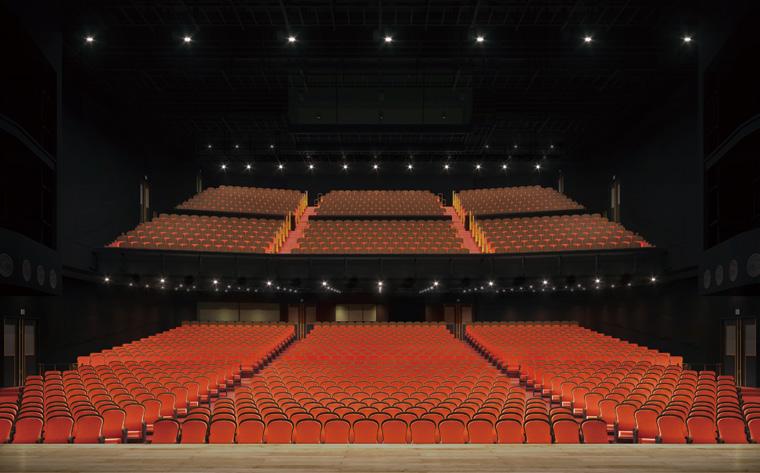


WATERS Takeshiba A City of Art and Culture on the Waters of Tokyo Bay ウォーターズ竹芝 2020 with Tokyo 2020

JR East Group has embarked on an urban redevelopment of Takeshiba as a dynamic waterfront center embodying art, culture, entertainment, retail, gourmet shops and restaurants, and hospitality. We met with Nita Souhei of the East Japan Railway Company, to discuss this colossal project.

The redevelopment project, WATERS Takeshiba, will include a sprawling public space with a lawn and terrace serving universal functions, such as restaurants, shops, offices, and venues for art and culture amidst the open view of Tokyo Bay. On the lower floors of the Tower building, atré Takeshiba will not only cater to shopping and gourmet stores and restaurants but also to an interactive hands-on museum for experiencing various activities. Some stores are scheduled to open on 13 April in advance. Together with the Theater building, which will house two theaters, the entire complex will have its grand opening on 14 July. Consolidating these two facilities, WATERS Takeshiba, therefore, will act as a commercial and cultural hub. After watching a play or musical, one can pass the time with a drink in one of the trendy bars while enjoying the soothing smell of Tokyo Bay. Mr. Nita remarks, “We would like to bring people and energy to this area by making WATERS Takeshiba a base for cultivating art and culture.”
The upper fl oors of the Tower building will be reserved for the new posh accommodation, mesm Tokyo Autograph Collection Hotel. It will offer the next level of hospitality with its “one-stop” staff service. From the hotel, a marvelous panoramic scenery of old and modern Tokyo can be thoroughly enjoyed. As Mr. Nita explains, “Since there is nothing open to see nearby, the view from the higher fl oors of the building will be absolutely beautiful not only for the sea, but also beyond where you can see the Rainbow Bridge and other buildings. From another angle, you can see the Hama-rikyu Garden and the modern skyscrapers of Marunouchi, as if the history of Japan is laid out before you amidst the modern cityscape.”
With regards to access, WATERS Takeshiba is just a six-minute walk from Hamamatsucho Station on JR Yamanote and Keihin Tohoku Lines. For tourists, Hamamatsucho Station will be the end of the monorail direct from Haneda Airport.


WATERS Takeshiba hopes to create a waterfront city of art, culture, business, and nature that would emanate pleasure and satisfaction not only to tourists but also to residents both as a weekend spot and also as a daily routine for shifting the mood from work to entertainment and pure relaxation with nature, right in the heart of Tokyo.
TOKYO PORTCITY TAKESHIBA 東京ポートシティ竹芝
TOKYO PORTCITY TAKESHIBA is a brand-new facility that’s due to open in 2020 and has plenty of shops, restaurants, and more. It has several lush terraces outside, which are laid out from the second to the sixth floor in a “step terrace” design. There’s also a huge event hall called “Port Hall,” and an atrium space called “Galleria,” which connects the pedestrian deck to the ground level.
©TOKYU LAND CORPORATION.
Toyosu Bayside Cross 豊洲ベイサイドクロス

© Mitsui Fudosan Co., Ltd.
Toyosu Bayside Cross is directly connected to Toyosu Station on the Tokyo Metro Yurakucho Line and very easy to access. Built to take advantage of the green scenery and the beautiful water, there are shops, the beautiful Cross Plaza, and, for those who fancy a game of table tennis, the aptly-named “Ping-Pong Forest.” If you’re hoping to extend your stay, there’s also a hotel with a public bath and stunning views.
Haneda Airport Garden 羽田エアポートガーデン
In preparation for the Olympics, a breathtaking new commercial complex called Haneda Airport Garden is set to open in the spring of 2020. It will have two hotels (one “original luxury brand” featuring guest rooms overlooking the Tamagawa River, and the other a high-grade hotel with dedicated women’s guest rooms and tatami rooms, etc.), a huge 2000m 2 hot spring (the first of its kind connected to the airport), and a total of 90 shops and restaurants.
The Rinkai Fukutoshin area, or the Tokyo waterfront sub-city center, faces Tokyo Bay and has already been immensely popular with tourists, who love it for places like the enormous Odaiba district. In addition, town development is also underway in other areas, such as Toyosu that now stations the new fi sh market, Haneda as an airport hub, and the port of Takeshiba that serves numerous ship departures.
© Sumitomo Realty & Development Co., Ltd.



Ariake Garden Ariake Garden will open sequentially from April 2020. Its status as one of the biggest commercial facilities in the Tokyo Bay Area, with over 200 stores, makes it a shopper’s paradise! Moreover, for those visitors who prefer a more relaxing trip (or, alternatively, who want to keep enjoying Ariake Garden with its beautiful greenery and fl owering trees), there’s also a hotel in the area with fi ve diff erent hot springs, which both guests and visitors can enjoy. 有明ガーデン
Situated at the famous fi sh market of Toyosu, Edomae Jokamachi has three separate areas for visitors to enjoy. First, the Toyosu Jokamachi food hall, where you can enjoy delicious seafood, as well as other Japanese food, such as udon and ramen. Second, for the shopaholics among you, the Shijo Koji marketplace is the best place to buy fish products and other souvenirs. Last, the Edomae Hiroba square, where you can sometimes find markets selling fresh produce, and the occasional event, is a great place where people can relax.
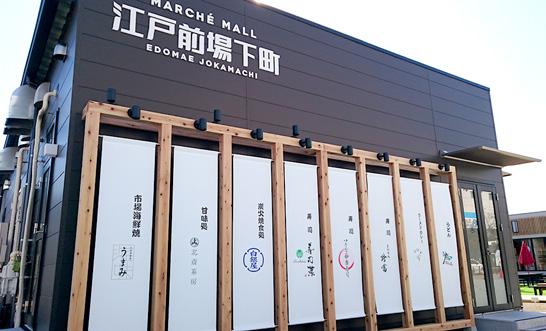

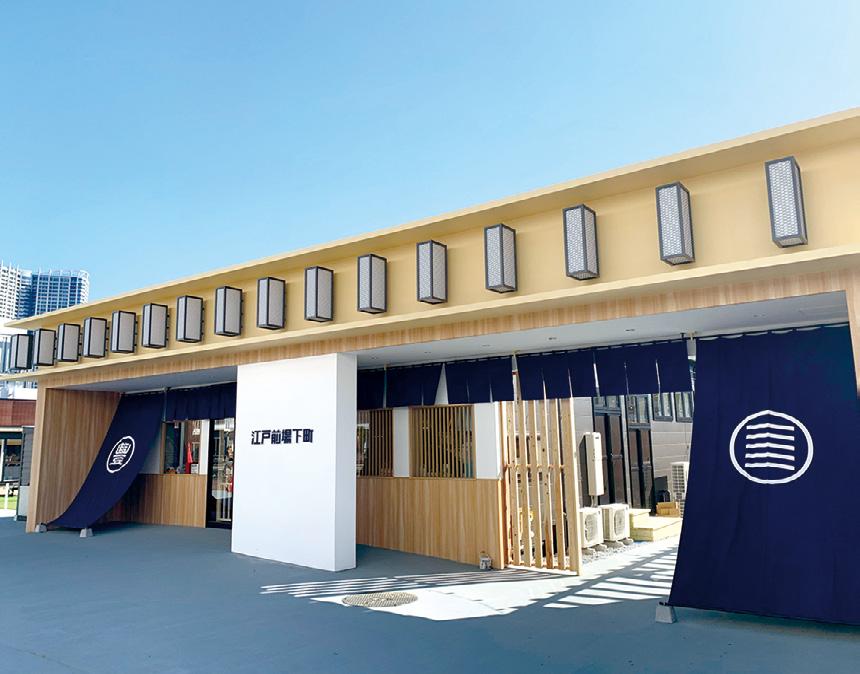
Edomae Jokamachi 江戸前場下町
HANEDA INNOVATION CITY 羽田イノベーションシティ

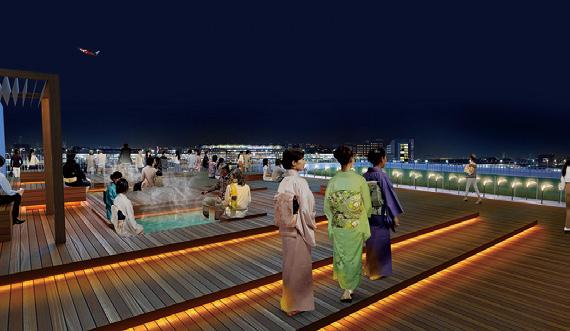

Haneda Airport, the gateway to Japan, has undergone an amazing transformation. With the opening of the HANEDA INNOVATION CITY complex, the airport area will no longer just usher tourists to Tokyo. It will also entertain them with gourmet dining, music events, hot springs, and other attractions. After a long fl ight, HANEDA INNOVATION CITY will surely feel like a beautiful oasis of culture and relaxation. Look forward to it during your next fl ight!
SHIBUYA SCRAMBLE SQUARE becomes a New Symbol of Tokyo 渋谷スクランブルスクエア
For years, the massive scramble crossing in front of Shibuya Station has been one of the undisputed symbols of Tokyo. Tourists from all over the world would, well, scramble to take pictures of themselves among a sea of people navigating the crossing, but now it seems that landmark has been overshadowed, literally, by a new addition to the area: the SHIBUYA SCRAMBLE SQUARE building.
Opening in November 2019, the SHIBUYA SCRAMBLE SQUARE was five years in the making, but the wait was more than worth it. About 230m and 47 fl oors tall, the towering structure overlooking the scramble crossing definitely makes an impression. However, it’s what’s inside it that really matters. Staying faithful to its original concept of “Mix Together and Generate: From Shibuya to the world,” the building seems to have it all. Besides offi ces, you’ll fi nd an impressive selection of 213 commercial outlets, including clothing stores, cafes, and restaurants spread throughout sixteen fl oors of the SHIBUYA SCRAMBLE SQUARE. Then, of course, there is the observation facility. three zones: SKY GATE, SKY STAGE, and the SKY GALLERY, the last one of which is an indoor observation corridor. But SKY STAGE, located on the roof fl oor, is probably the most exciting option because it’s situated outdoors, off ering unobstructed 360-degree views of Tokyo and its landmarks like Tokyo Tower, Roppongi Hills, TOKYO SKYTREE ® , and Tokyo Bay. There are also places where visitors can take breathtaking shots of Mt. Fuji.
No visit to the SHIBUYA SCRAMBLE SQUARE would be complete without a look around its souvenir store. The store sells many original Tokyo-themed goods, which would make great reminders of your walk above the busy streets of Japan’s capital.
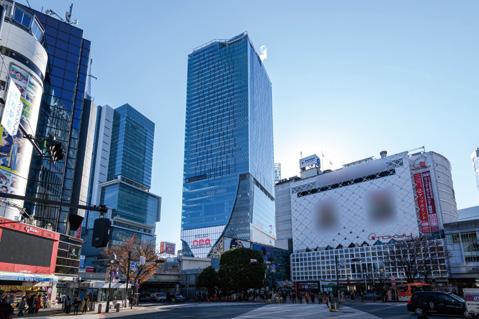
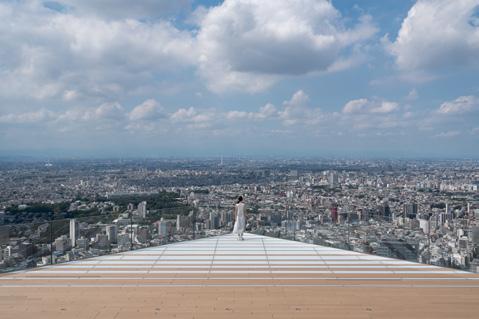
Called the SHIBUYA SKY, the observation area is made up of

The SHIBUYA FUKURAS skyscraper, located just outside Shibuya Station, is a busy place. With a bus terminal, luggage storage services, and an innovative tourist information center crossed with an art gallery, the building seems tailor-made for international visitors. The new structure stacks over 22 floors, four of which are underground, for them to discover.
The driving idea behind the FUKURAS was “a collection of little stories,” which is why the building also houses offices, stores, and a wide selection of restaurants. Floors 2 – 8, as well as 17 and 18, are occupied by the Tokyu Plaza retail space off ering everything from cosmetics to kitchenware. Once you’re done shopping and eating, head on up to the rooftop SHIBU NIWA open-air garden and take in the amazing views of Shibuya.
SHIBUYA FUKURAS 渋谷フクラス

Photo by Christopher Jue /Getty Images for Tokyu Land Corporation
New Harajuku Station Building & WITH HARAJUKU Harajuku and Shibuya are both changing rapidly, and soon Harajuku station, the oldest original wooden station in Tokyo, will be replaced with a larger, contemporary structure. The remodeling will help manage the ever-growing number of pedestrians in Tokyo and make visiting Harajuku easier for everyone. It’s perfectly situated if you want somewhere to relax or shop, as the new location WITH HARAJUKU is right in front of the Harajuku station building. 原宿駅&ウィズ原宿
New Harajuku Station Building © East Japan Railway Company

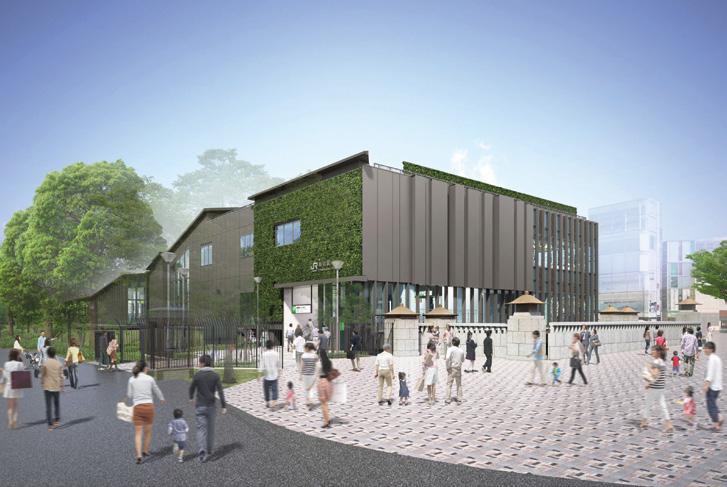
Set to open in April 2020, WITH HARAJUKU is designed using many natural materials. It will be created as a “hang out place of the future” that includes not only restaurants and shops, but also halls, shared spaces, and rented residences. You can also enjoy walking along “WITH HARAJUKU STREET,” which connects Harajuku Station with the wildly popular shopping area of Takeshita Street, forming an attractive streetside store space.

WITH HARAJUKU
okyo tea culture: A taste of T
Japanese tea is popular around the globe for its avor and health bene ts. With a place on the table along with many traditional dishes, it rises to the top of the country’s culinary culture. However, this special drink is more than just a thirst quencher. Japanese tea — like matcha (powdered green tea), hojicha (roasted green tea), and green tea — plays a major role in the spirituality of Japanese culture, especially during the tea ceremony, or sado. Even Tokyo, a shining example of modern Japan, nds quiet time for this centuries-old tradition, with innovative twists.
Sharing Tea with Kobori Sojitsu: A Grand Master of Enshu SADO School

Kobori Sojitsu making tea at the beginning of 2020. This tea ceremony is called Keikoshokon tatezome .
The art and philosophy of the tea ceremony have infl uenced many aspects of Japan’s aesthetic and spirituality throughout the years. The ritual, with its choreographed motions and various utensils, was considered to be a highly refi ned cultural experience, even by some of Japan’s most fearsome warriors. Like a delicious Japanese dish, though the main ingredients are similar, the presentation of the tea ceremony diff ers across Japan as masters have their own interpretations.
Enshu SADO School is a tea ceremony pioneered by Kobori Enshu, a feudal lord in the early 17 th century. This style incorporates the elegance and powerful presence of the Japanese samurai who enjoyed the refi nement of the tea ceremony. After 440 years, the ritual and philosophy are continued by the Enshu
SADO School based in Tokyo. The philosophy of Enshu SADO School runs deeply through all of the art presented during the tea ceremony. So even though the ritual is centuries old, new ideas and works are formed with Enshu SADO School as the backbone.
Japanese tradition in the modern world
Chabana (fl owers for a tea occasion) for March. Akebono-tsubaki (Camellia japonica) and shiromoji (Lindera triloba) in the Chinese bronze vase the Kodo Kojiguchi Karamatsu-mimitsuki.

e leaders who in uenced Kobori Enshu
As the 13 th Grand Master of Enshu SADO School, Kobori Sojitsu knew the story of Kobori Enshu, the original Grand Master, as if he had lived the life himself. At the time of Kobori Enshu’s birth in 1579, it was nearing the end of the Sengoku period under the reign of Azai Nagamasa. By the time he was 10 years old, he was already gaining favor among Sengoku military commanders for his many talents.
As the Sengoku period (from the end of 15 th century to the end of 16 th century) faded deeper into the past, the Tokugawa Shogunate longed for peace and culture. Eventually, he became something like a chief of Cultural Aff airs, where he could focus on refi nement in the new age. At this time, Enshu’s ideas began to enter the mainstream.
Kirei-sabi: Integration of sophistication and simplicity
The tea ceremony bowl Katate Jumonji-kodai Chawan. It represents Kobori Enshu’s favorite image of “white” with the exquisite harmony of decorous form and glaze.
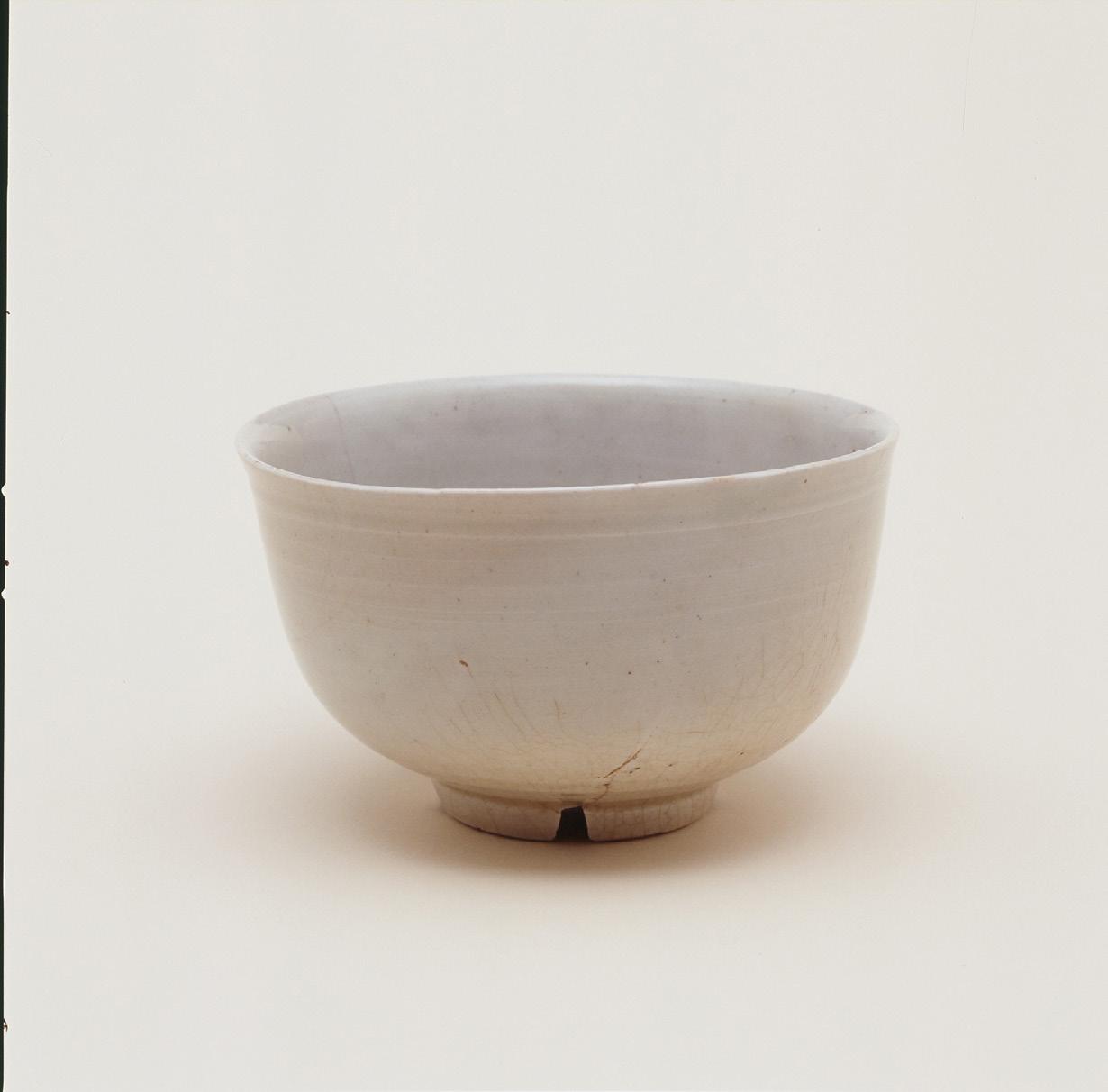
poetry, simplicity, and art into the tea ceremony, Kobori Enshu used his fi ne taste to mold the concept of kirei-sabi, which is the core essence of Enshu SADO School.
Kire-sabi is where spirituality meets beauty and luminance. This quality of Enshu SADO School is called senrensei no aru chowa no bi , which means “the beauty of harmony with sophistication.” Looking at the calligraphy, paintings, fl ower arrangements, and teacups, calmness can be felt. Unlike some other forms of art and fashion, kirei-sabi doesn’t try to overwhelm you. Instead, it elegantly focuses on a key aspect to maximize the impact of the subject. Kobori Sojitsu describes this balance like a good fi lm with the main character in the spotlight who is supported by the other cast members. If one actor were to attempt to outperform the lead, the art would suff er as a whole. This sense of mutual respect and thoughtfulness — known as wakeiseijaku — forms the canvas on which sado art pieces are created.
Kobori Sojitsu
e 13 th Grand Master of Enshu SADO School

He received Fuden-an Sojitsu as his zen and tea name from the Grand Zen Monk Fukutomi Settei, the head of the Daitoku-ji Temple in Kyoto in 2000 after his study there. He became the 13 th Grand Master of Enshu SADO School on New Year’s Day in 2001. As a part of keeping the traditions and spirituality of the tea ceremony,as well as creating a tea ceremony that continues to be meaningful in a contemporary world, he collaborates with artists in various fi elds and actively participates in overseas cultural programs. He believes that “tea brings richness in minds”.
*All the photos ⒸEnshu SADO School
▼ keep reading here: ▶
Wherever your tastes run to, be it traditional tearooms and tea ceremony, or the more contemporary matcha eclairs, gelato or pound cake, or anything, in fact, matcha-related, you can nd it here. Any one of these shops will let you enjoy a truly Japanese experience in beautiful, and sometimes very unique, surroundings.
Come enjoy delicious Japanese tea avors at these restaurants!

Green tea is popular throughout Japan, and with so many shops and cafés off ering green tea or matcha drinks and dishes, it can be diffi cult to choose where to go. One thing’s for sure, though: whether you want Unkai’s dishes, tea on rice from Kurogi Chacha, innovative matcha sausages from CHAYA 1899 TOKYO, matcha soba from Jugetsudo Ginza Kabukiza, or desserts from Ginza Fugetsudo — Japanese tea is available in so many forms that you’re sure to fi nd your perfect green tea or matcha match!

UNKAI JAPANESE RESTAURANT in ANA INTERCONTINENTAL TOKYO
Ureshino-cha, from Saga prefecture, is one of the rarest and most precious green tea varieties in Japan, and the Japanese restaurant, UNKAI, has come up with a seasonal kaiseki-ryori (full course meal form of Japanese cuisine) that pairs diff erent strains of Ureshino-cha with various exquisite dishes*. Why not stop by and taste this rare tea, from a place which has been well-known for its quality tea leaves for around 500 years?
The Japanese restaurant, UNKAI, is situated in a beautiful location that overlooks a traditional Japanese garden and pond, which have been designed to take advantage of the beauties of each season. There are also private dining rooms for those who want a more intimate experience.
The smooth, delicate fl avor of Ureshino-cha shouldn’t be missed, and the delicious combination of this precious tea and well-chosen special dishes make for an unforgettable experience. *This menu will end on 31 May.
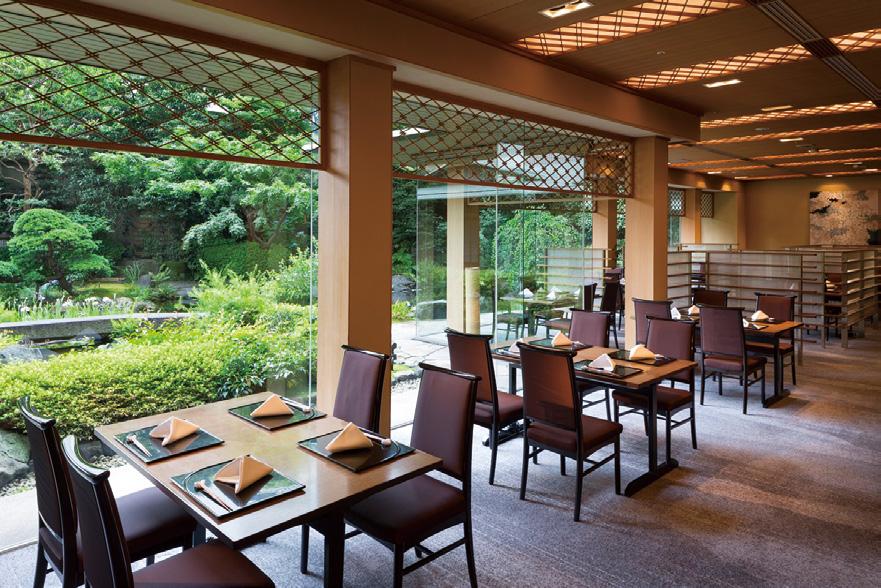
Jugetsudo Ginza Kabukiza

Designed by the world-class architect, Kuma Kengo, around the concept of a bamboo forest, the Jugetsudo Ginza Kabukiza tea house combines two Japanese tastes: matcha and soba noodles. For visitors who are curious about tea culture, they off er a tea experience course, and a bilingual tea ceremony for beginners (reservations required for both). Jugetsudo has a beautiful lounge for customers to relax and savor the Japanese tea/confectionery combination, and there are also light meals.


KUROGI CHACHA
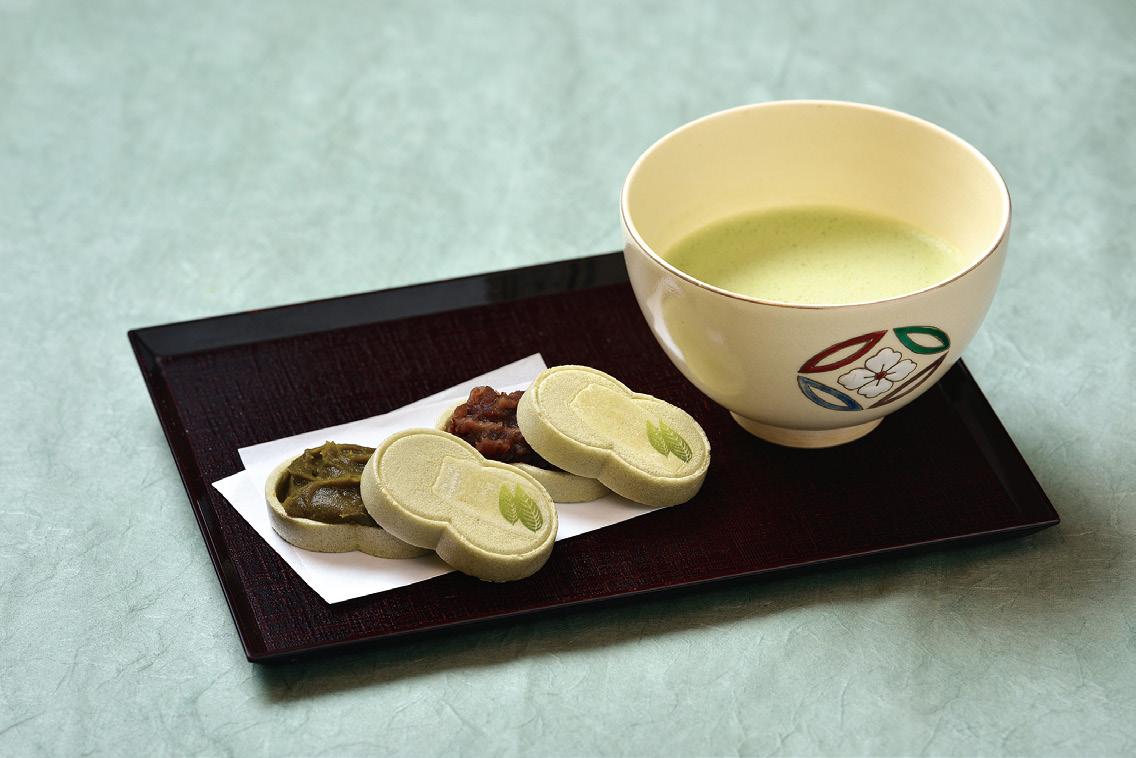


The shop KUROGI CHACHA in GINZA SIX has taken the Japanese love for tea to new heights, with famous Japanese cuisine chef Kurogi Jun basing the creations on Ujicha from Fukujuen, a traditional tea shop in Kyoto. The restaurant is laid out like a tearoom and off ers a meal of miso (bean paste) soup, all-you-can-eat rice, tai (sea bream), and chazuke (tea on rice) with tai and a selection of teas. To fi nish, there are delicious desserts and you can enjoy those appetizing sweets with delightful matcha!
CHAYA 1899 TOKYO in HOTEL 1899 TOKYO


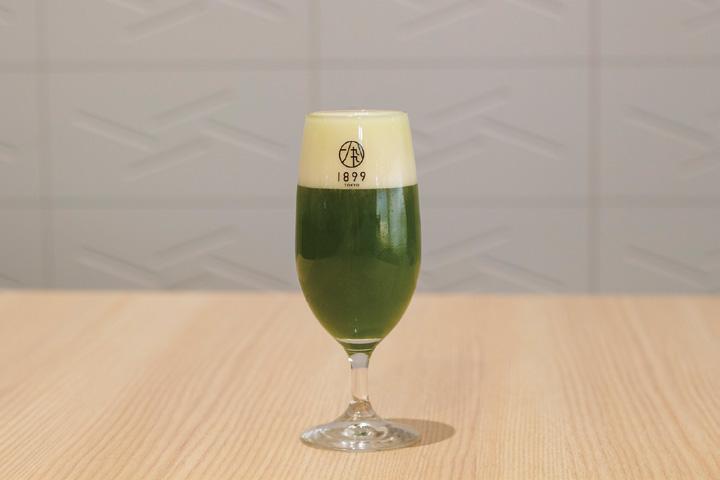
Although chaya is generally described as a Japanese teahouse, the truth is that CHAYA 1899 TOKYO is managed to integrate the delicate fl avor of Japanese tea into everything. While this isn’t too surprising when it comes to things like ice cream, CHAYA 1899 TOKYO has succeeded in making matcha-fl avored beer, soda, and sausages! With a wide range of choices, CHAYA 1899 TOKYO is the best place for those looking to enjoy a light meal with delicious drinks in a fresh, natural atmosphere.
Ginza Fugetsudo
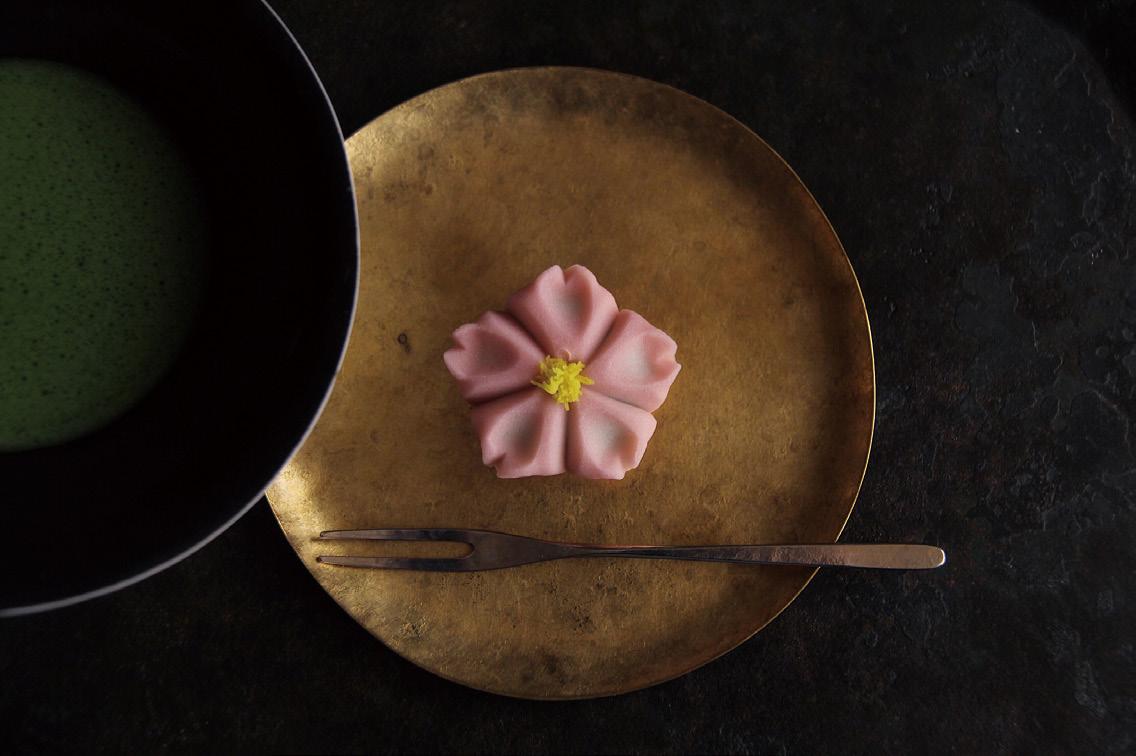


Ginza Fugetsudo is a place that sells delicious sweets and a selection of teas. The sweets use seasonal ingredients to create a menu that’s always fresh and intriguing. The shop also off ers rice and fi sh lunch dishes for those visitors looking for something more substantial, and an evening ‘seasonal course,’ along with the option to buy sweets made by craftsmen using locally-sourced ingredients. As the menu changes every month, even returning customers can fi nd brand-new teas and sweets here.





